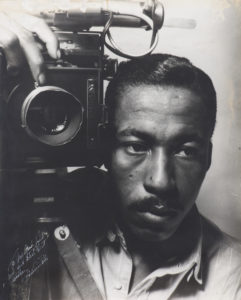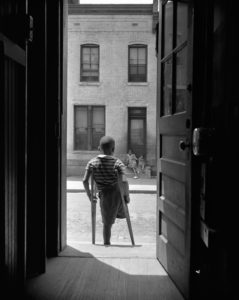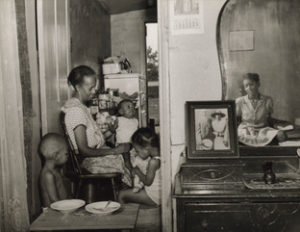


Gordon Parks: The New Tide, Early Work 1940-1950 at the National Gallery of Art has something for everyone, but this exhibit will especially resonate with Southwesters. In the fall of 1942, when Parks worked for the Office of War Information, he and his family lived at 63 O St., SW in housing built for defense employees.
Parks described his time here as “getting along fine and getting a wonderful experience.” In the collection of black and white photographs in The Home Front, he documented the grimness of the area with its substandard housing slated for removal.
The other four galleries in the exhibit cover a range of the early works of this remarkable self-taught artist.
Parks had decided that the camera would be his choice of weapon and so his first works are appropriately grouped as A Choice of Weapons (1940–1942). This collection features his elegant society portraits as well as events such as the South Side Community Art Center dedication in Chicago in May 1941 with First Lady Eleanor Roosevelt in attendance. Renowned poet and playwright Langston Hughes, philosophy professor and architect of the New Negro movement Alain Locke, and opera singer Todd Duncan are included in this section.
Government Work (1942) features photographs created during his short time with the Farm Security Administration, when he was tasked with photographing the Frederick Douglass Dwellings—public housing constructed in DC’s Anacostia neighborhood for black defense workers. Very different than the Southwest photographs, these suggest a more pleasant life: a mother looking through her kitchen window at her children in the yard as she prepares the evening meal and another of a family saying grace at the dinner table. His photos of young children especially capture their playful, spirited energy.
In his continuing efforts to document racism in DC at this time, Parks photographed Ella Watson. His iconic portrait, Washington, D.C. Government Charwoman (American Gothic), has her posed with her mop and broom in front of an American flag. Parks also chronicled her life with her family in their home and at church. Thus with his photographic skills he created these narratives that are now social documents.
Standard Oil (1944–1948) includes a set of rarely seen works Parks produced for Stryker at Standard Oil Company (New Jersey), for the company’s public relations campaign during wartime shortage. To photograph the “face of oil,” he traveled through the Northeast US and into Canada, capturing the grittiness of coal workers, refinery operators, pipe fitters, railroad workers, grease makers, drilling crews and miners, in the cities, towns, schools, shops and farms that depended on the petroleum industry.
Parks truly photographed humanity in its diversity. There are celebrity portraits of historic notables like singer Marian Anderson and the educator Mary McLeod Bethune and there are photographs of unknown fishermen in Gloucester, Mass., and at the Fulton Fish Market in New York.
Mass Media (1945–1950) focuses on Parks’ photography for major fashion and lifestyle magazines, including Ebony, Circuit’s Smart Woman and Glamour. In 1949 he was hired as the first African American photographer for Life magazine where his work covered the high fashion scene in Paris and actress Ingrid Bergman on the set of the film “Stromboli.” Along the way, he documented segregation, street life and poverty from Puerto Rico and Fort Scott to Paris and Portugal.
From a start in life with a struggle to survive, through these significant early years of his career, Parks would go on to more successes in the next fifty years. He was the first African American director of a major Hollywood film with the “Learning Tree” (1969), followed by “Shaft” (1971), as well as the author of many books, a musical composer and a poet.
In conjunction with this exhibit before it travels to three other museums in the next year, the National Gallery of Art is offering a range of public activities.
From Jan. 5 to Feb. 17, 2019, the National Gallery will present a retrospect of his films and videos including “The Learning Tree.”
From Feb. 8-10, the John Wilmerding Symposium on American Art and Community Celebration: Artists and the American Community will host dialogues with artists and scholars held in conjunction with the exhibition. A related community celebration on Feb. 9 and 10 will feature a program for all ages that blends photography, film, spoken word and music.
For more information about the exhibit, visit https://www.nga.gov/exhibitions/2018/gordon-parks-the-new-tide-1940-1950.html.
By Sheila Wickouski

